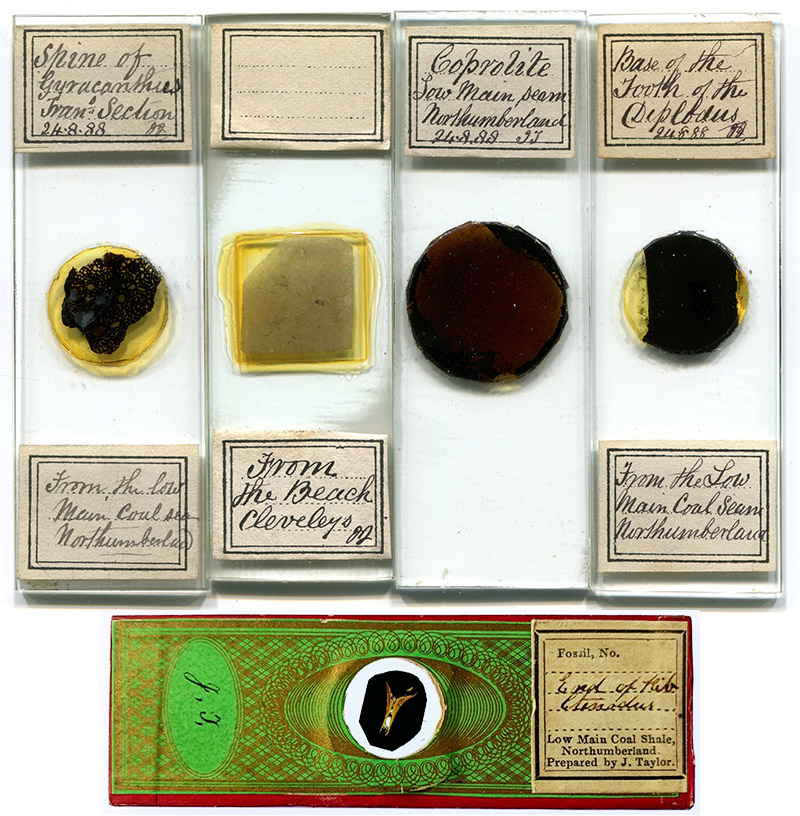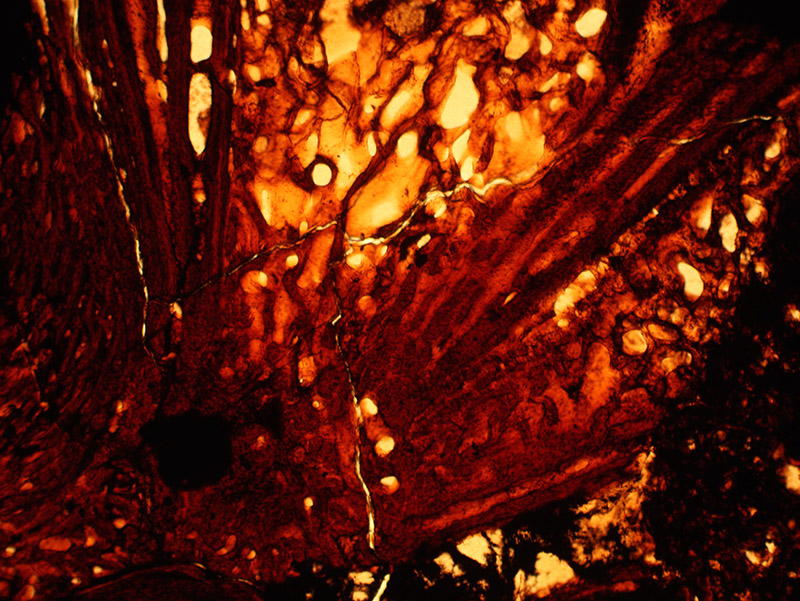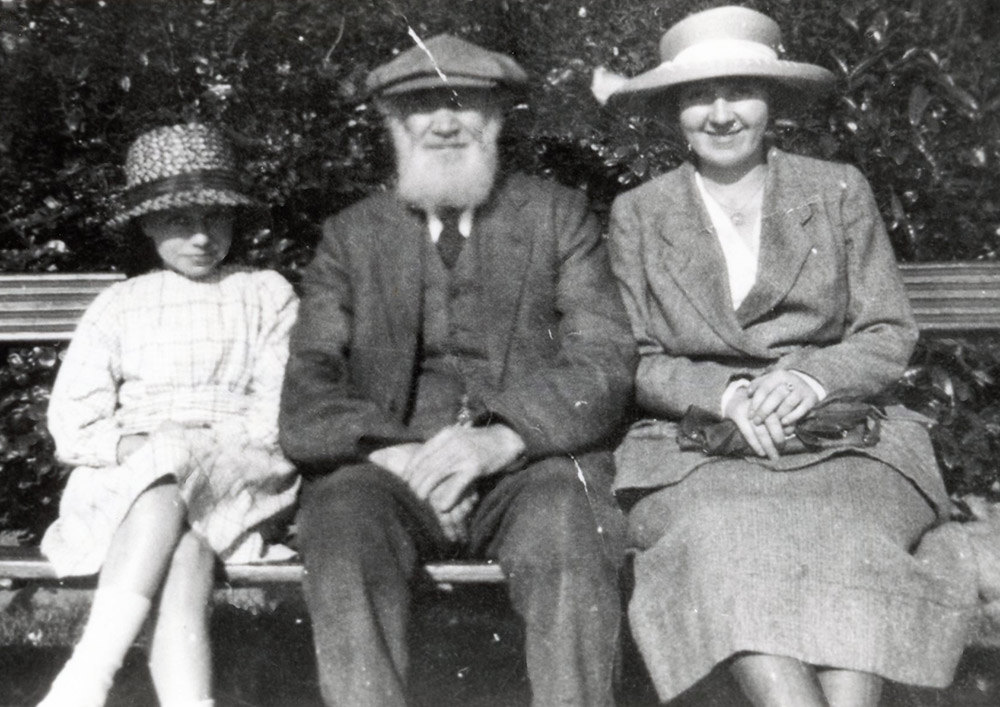Joseph Taylor, 1840 - 1925
by Brian Stevenson
last updated January, 2022
Victorian era slides of fossils from Northumbrian coal signed “J.T.” can be attributed to Joseph Taylor due to the subject matter, their locations of origin, and dates. Taylor was a coal miner and amateur microscopist, well-regarded for his prepared microscope slides.

Figure 1.
Examples of microscope slides produced by Joseph Taylor. The printed label on the lower example is similar to those used on geological slides that were made by Taylor's brother-in-law, John Simm. Images from slides in the author's collection, or adapted for nonprofit, educational purposes from an internet auction site.

Figure 2.
Detail of “Bone of the Megalichthys” from the Low Main Coal Seam, Northumberland, mounted by Joseph Taylor in 1888 (see Figure 1). Photographed using a C-mounted digital SLR camera on a Leitz Ortholux II with a 3.5x objective lens.

Figure 3.
Joseph Taylor and two of his granddaughters. Kindly provided by Joseph's great great granddaughter, Joanna Lawson.
Joseph Taylor was born during the autumn of 1840, the third son of Thomas and Elizabeth Taylor of Earsdon, Northumberland. The 1841 census described Thomas as a “mason”. The father evidently died in about 1844. Elizabeth remarried, to a coal miner with the surname Lashley, possibly Robert Lashley. Lashley had a son from a previous marriage, and he and Elizabeth had one child together. Lashley died shortly thereafter, such that the 1851 census recorded Joseph Taylor living with his two brothers and a younger sister, his 4 year-old half-brother, his mother Elizabeth Lashley (“Coal miner’s widow”), and adopted brother Thomas Lashley. The census states that 10 year-old Joseph was a “scholar”, although he probably soon went down to work in the coal pits with his brothers Thomas (age 12) and William (age 16) and Thomas Lashley (age 19).
Joseph moved a short distance to West Cramlington, where he was recorded as a “coal miner” in the 1861 census. It was there that he married Ann Simm in early 1862. Ann was a younger sister of John Simm, another notable coal miner / microscopist. Joseph and his brother-in-law were frequently mentioned together in publications that described amateur scientists or fossils from coal beds.
Edward Young wrote on “Miners with scientific tastes” in 1876, “Joseph Taylor, a workingman, residing at West Cranleyton, is a relative of Mr. Simms by marriage, and his tastes and capacities very similar to those possessed by his brother-in-law. He has a good collection of lower coal-measure fossils; he also mounts objects for the microscope, and he and Mr. Simms both supplied Mr. West the slides for his work on coal-measure paleontology. Mr. Taylor is about forty years of age, and for several years has devoted his leisure hours to paleontology”. E.T. Cook wrote, “Mr. John Simm, West Cramlington, and Mr. Joseph Taylor, Shiremoor, both pitmen, … are able local geologists. They are also, although middle-aged men, students at the local lectures”.
Taylor advertised to provide prepared microscope slides in March, 1869, implying that he had substantial mounting experience by that time, “Good Fossil Sections of Teeth, Bones, Scales, &c., of Fish, for good Slides of Photographs. - Joseph Taylor, West Cramlington, Northumberland”.
Also in 1869, Thomas Barkas wrote on fossils from Northumbrian coal, noting that “within the last few years Messrs. Kirby, Sim, Taylor, and Craggs have each secured good collections of the Carboniferous fossils”.
Barkas routinely acknowledged contributions from Taylor and other miners. An 1871 description of a fossil tooth included “to (John Simm) and Mr. Joseph Taylor I am deeply indebted for valuable aid in making an almost complete series of sections of remains of coal-measure fishes and reptiles”.
Another 1871 article on fossil vertebrae reported “The seam of coals known as the High Main lies at an average distance of thirty fathoms above the Low Main, and until the discovery of these three reptile vertebrae no reptile remains had been found in the High Main, and so far as my knowledge goes, fish remains have not been discovered in that seam. The chief feature of the shale of the High Main is the presence of a profusion of fossil plants, and it was while looking for fossilised flora that Mr. Joseph Taylor, of West Cramlington, much to his surprise, discovered the three vertebrae in question”. This last comment indicates that Taylor actively hunted for fossils while mining coal.
Two years later, Barkas named the source animal Amphicoelosaurus taylorii, adding “The discovery of vertebrae in the strata associated with the High Main Coal is, so far as I have been able to ascertain, an absolutely new discovery, and the credit of it belongs to Mr. Joseph Taylor, of West Cramlington, who found the three vertebrae I am about to describe, and to whom also belongs the credit of discovering, on a subsequent occasion, and in my presence, a mass of coprolitic matter, in the post of the High Main Coal Seam”.
In 1872, Barkas wrote, “By the kindness of Mr. Joseph Taylor, of West Cramlington, I have received for examination a very excellent left mandible of a new coal-measure reptile or labyrinthodont. With the exception of mandibles of Batrachiderpeton, no small coal-measure reptile jaws have been discovered in the Northumberland coal shales, and I have pleasure, therefore, in introducing to your palaeontological readers a description and illustration of the new reptile lower jaw”.
Barkas wrote in 1873, “About seven years ago I saw for the first time, under microscopic power, the woody structure of a plant obtained from the Northumberland true coal-measures, and until today I have not had an opportunity of examining another microscopical section of coal-measure plant. The first specimen was the merest fragment, and was shown in a microscopical section of Low Main coal. The latter specimen, or rather specimens, because there are two prepared slides, consists of sections of the fruit or cone of a Lepidodendron known as Lepidostrobus. These specimens were discovered, and have been prepared by Mr. Joseph Taylor, of West Cramlington, and they exhibit in a very satisfactory manner the cellulose or woody structure characteristic or vegetable products”.
Barkas’ 1873 Illustrated Guide to the Fish, Amphibian, Reptilian, and Supposed Mammalian Remains of the Northumberland Carboniferous Strata repeatedly thanked Taylor and others for their contributions to paleonotology, such as “I have, during the progress of my investigations into Coal Measure Fauna, which have now extended over five years, been much indebted to Messrs. Simm and Taylor, of West Cramlington, and Mr. J. Salt, of Newsham, all of whom have kindly placed their large and valuable collections of fossils at my disposal; and the two former of whom have kindly, in addition to the use of their fossils, prepared for me gratuitously nearly all the microscopical sections which appear in the various plates that illustrate this work”, and “The transverse section of a tooth … is the first of a remarkable series of sections of Reptile and Labyrinthodont teeth which have been rubbed down and mounted for microscopic examination by Messrs. Simm and Taylor, of West Cramlington, from specimens in their cabinets and in my own”.
Thomas Stock, of the Natural-History Department, Museum of Science and Art, Edinburgh, wrote in 1880, “Amongst a parcel of fish-remains sent me a few months ago by Mr. Joseph Taylor of Shire Moor, Northumberland, was a spine which Mr. Taylor said he believed was new. After a careful study of the specimen, and after consulting all the literature of the subject accessible to me, I came to the conclusion that the spine was not only specifically new, but must be regarded as the type of a new genus … A small piece of about 7 millims. had been removed by Mr. Taylor, with the intention of preparing a microscopic section from it … The specimen appears to be unique. Until discovery throws light upon its true affinities it must remain as the type of a new genus, which I propose to call Lophacanthus; and to it I add the specific name of Taylori, in honour of the discoverer”.
In addition to those contributions, Taylor donated several specimens to the Natural History Society of Northumberland, Durham, and Newcastle-upon-Tyne, including “A specimen of Fossil-wood, from a sandstone quarry at Byker; also a specimen from a quarry at Benton Square” in 1879, “Specimen of Fossil Wood, from the High-Main Seam, Shiremoor Colliery” in 1883, and “Specimen of Cyclopteris from shale above the ‘Yard-seam’, Shiremoor Colliery” in 1900.
Other than the aforementioned 1869 exchange offer, only two further advertisements from Taylor have been identified: “Will exchange slides of fossil fish remains, for good pocket lens, section cutter, frog plate, live cage; correspondents invited - Joseph Taylor, Shire Moor, via Earsdon, Newcastle-upon-Tyne” (1879), and “Will exchange micro-sections of coal measure fish remains for Professor A. Geikie's ‘Advanced Book on Geology’ - Joseph Taylor, Shire Moor, via Earsdon, Newcastle-on-Tyne” (1883).
Taylor was still working as a “coal miner under ground” when 60 years old, according to the 1901 census. He lost several fingers in a 1902 mining accident. Joseph died at the age of 84, on March 17, 1925. According to his death record, he had "senile decay", and died from exposure one night after "losing his way and falling down in the dark".

Figure 4.
Spine of Lophacanthus taylori, (top) adapted from Thomas Stock’s 1880 publication, (bottom) recent photograph of Taylor's fossil in the Tyne and Wear Museum, generously provided by Joanna Lawson.
Acknowledgement
Thank you to Joseph Taylor's great-great granddaughter, Joanna Lawson, for sharing information and family pictures. I am especially pleased that her late father, Joseph's great grandson, took delight in this essay.
Resources
Barkas, Thomas P. (1869) Notes on various species of Ctenodus found in the Low Main coal-shale, Newsham Colliery, Northumberland, Geological Magazine, Vol. 6, pages 314-316
Barkas, Thomas P. (1871) Tooth of Amphisaurus amblyodus, English Mechanic and World of Science, Vol. 12, pages 540-541
Barkas, Thomas P. (1871) Reptile remains in a new locality, English Mechanic and World of Science, Vol. 14, page 150
Barkas, Thomas P. (1872) New reptile mandible, English Mechanic and World of Science, Vol. 16, page 173
Barkas, Thomas P. (1873) Structure of Lepidostrobus, English Mechanic and World of Science, Vol. 16, page 578
Barkas, Thomas P. (1873) Illustrated Guide to the Fish, Amphibian, Reptilian, and Supposed Mammalian Remains of the Northumberland Carboniferous Strata, W.M. Hutchings, London
Cook, E.T. (1884) The university extension movement, quoting R.D. Roberts, in Proceedings of the International Conference on Education, Vol. 4, edited by R. Cowper, published by W. Clowes and Sons, London, pages 252-266
Davis, James W. (1892) On the fossil fish remains of the coal measures of the British Islands: Part 1, The Scientific Transactions of the Royal Dublin Society, Vol. 4, series 2, pages 745-746
England census, birth, marriage, and death records, accessed through ancestry.co.uk
Hardwicke’s Science-Gossip (1869) Exchange offer from Joseph Taylor, Vol. 5, page 72
Hardwicke’s Science-Gossip (1879) Exchange offer from Joseph Taylor, Vol. 15, page 192
Hardwicke’s Science-Gossip (1883) Exchange offer from Joseph Taylor, Vol. 19, page 216
Stock, Thomas (1880) On a Spine (Lophacanthus Taylori, mihi nov. gen. et spec.) from the Coal-measures of Northumberland, The Annals and Magazine of Natural History, Vol. 5, pages 217-220
Transactions of the Natural History Society of Northumberland, Durham, and Newcastle-upon-Tyne (1888) Donations from Joseph Taylor, Vol. 9, pages 289 and 291
Transactions of the Natural History Society of Northumberland, Durham, and Newcastle-upon-Tyne (1900) Donation from Joseph Taylor, Vol. 13, page 216
Transactions of the Natural History Society of Northumberland, Durham, and Newcastle-upon-Tyne (1906) Donations from Joseph Taylor: “The donor's collection of Coal Measure fossils, chiefly from Shiremoor; all selected examples. Also some fossils from the Carboniferous Limestone, Permian, Lias and Chalk. A stone axehead found at Earsdon, Northumberland, and a set of Danish flint implements”, Vol. 1, new series, page 488
Woodward, Arthur S, and Charles D. Sherborn (1890) “Mr. John Simm and Mr. T. Cragges, of West Cramlington, and Mr. Joseph Taylor, of Shire Moor, have also done much in their respective districts”, A Catalogue of British Fossil Vertebrata, Dunlau & Co., London, page xi
Young, Edward (1876) Labor in Europe and America, S.A. George & Co., Philadelphia, page 417



